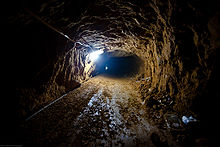- Smuggling tunnel
-
Smuggling tunnels are secret tunnels, usually hidden underground, used for smuggling of goods and people. The practise began in 17th century Cornwall, England and has continued all over the world. The term is also used where the tunnels are legitimate responses to aggression or siege e.g. during the siege of Sarajevo.
Contents
Smuggling tunnel in Sarajevo, Bosnia
During the Siege of Sarajevo a tunnel underneath the no-man's land of the city's (closed) airport provided a vital smuggling link for the beleaguered city residents. Guns were smuggled into the city and (at what critics said were exploitively high rates) people were smuggled out.
It features in the British film "Welcome to Sarajevo" and a similar tunnel in an unknown city, but likely Belgrade features in the dark Serbian satire of conflict "Underground".
Smuggling tunnels in Rafah, Gaza Strip
Main article: Gaza Strip smuggling tunnelsGaza Strip smuggling tunnels connect Egypt and the Gaza Strip, bypassing the Egypt-Gaza Strip barrier built by Israel along the international border established by the Israel-Egypt Peace Treaty. The tunnels pass under the Philadelphi corridor an area specified in the Oslo accords as being under Israeli military control, in order to secure the border with Egypt.
The American smuggling tunnels
Early history
Shanghai tunnels have been used to smuggle people out of the United States to work as slaves aboard ships.[citation needed]
U.S.-Canadian drug smuggling tunnel
In early 2005, a group of Canadian drug-smugglers took up the idea, and constructed a tunnel between a greenhouse in Langley, British Columbia and the basement of a house in Lynden, Washington, which lay across the ditch marking the United States-Canada border (the house on the Langley side was on 0 Avenue ("Zero Avenue"), which runs parallel to the border and is the baseline of Langley's avenue-numbering system). They bought the two properties and began construction work. Authorities were alerted when a neighbour noticed the large-scale construction work being undertaken in the greenhouse. On inspection, it was apparent that tons of construction material was entering, and piles of dirt were coming out.
It became known within a short time by both American and Canadian border authorities that a tunnel was being built. Video and audio devices were installed secretly by customs officials both at the termini and in the tunnel itself.
On July 14, the tunnel having been completed, the first packs of marijuana began going through. Officials raided the home soon after and arrested the three men. They then appeared before court in Seattle.[1]
U.S.-Mexican smuggling tunnels
On January 25, 2006, the largest smuggling tunnel to date was found on the US-Mexico border by a joint U.S. Drug Enforcement Administration, U.S. Immigration and Customs Enforcement, and U.S. Border Patrol task force. The 2400-foot-long (720m) tunnel runs from a warehouse near the Tijuana airport to a warehouse in San Diego. When discovered, it was devoid of people, but it did contain 2 tons of marijuana. It was 5 feet high and up to 90 feet deep. The floor was made of cement and the walls were exposed clay, with lights lining one side, a ventilation system to keep fresh air circulating, and a water drainage system to remove infiltrating ground water. Authorities said it was unclear how long the tunnel had been in operation.
On January 30, U.S. Immigrations and Customs Enforcement agents arrested a Mexican citizen, who was linked to the tunnel via the U.S. warehouse, operated by V&F Distributors LLC. On the Friday before, January 27, immigration authorities reportedly received information that the Mexican cartel behind the operation was threatening the lives of any agents involved with the construction or occupation of the tunnel. US Customs and Immigration, however, pledged to protect them as best they can. Authorities believe Tijuana's Arellano-Felix drug syndicate, or some other well-known drug cartel, was behind the building and operation of the tunnel.[2]
On November 26, 2010, a 2,600 foot (800m) tunnel was discovered linking Tijuana to Otay Mesa, California.[3]
An analysis of U.S.-Mexican smuggling tunnels, the U.S.-Canadian smuggling tunnel and the smuggling tunnels in the Rafah, Gaza Strip was completed by Lichtenwald and Perri as part of a transnational analysis of smuggling tunnels.[4] Lichtenwald and Perri outlined sources and methods for evaluating which tunnels are used by different populations in various parts of the world to smuggling contraband that does not threaten a nation’s security as opposed to tunnels that smuggle contraband that do threaten a nation’s security. Hybrid tunnels, tunnels that smuggle contraband that threaten a nation’s security as well as those that do not, are detailed
See also
- Ask a Policeman, a smugglers tunnel being integral to the plot.
- Escape tunnel
- Illegal drug trade
- Illegal immigration
- Illegal immigration to the United States
- Smuggling
References
- ^ Ken MacQueen (02 November 2005). "B.C.'s tunnel busters". Macleans.ca. Archived from the original on 2010-12-06. http://www.webcitation.org/5umtWSYfH.
- ^ Drug haul in secret border tunnel, BBC News, 27 January 2006
- ^ Second Mexico-US drug tunnel found in Tijuana, BBC News, 26 November 2010
- ^ Terrance G. Lichtenwald, Frank S. Perri, Smuggling Tunnels: The Need for a Transnational Analysis Inside Homeland Security Spring 2011 Volume 9, Issue 1 http://www.all-about-forensic-science.com/support-files/tunnels.pdf
External links
Categories:- Tunnels
- Smuggling
- Crime
- Mexico–United States border
- Secret places
- Subterranea (geography)
Wikimedia Foundation. 2010.

